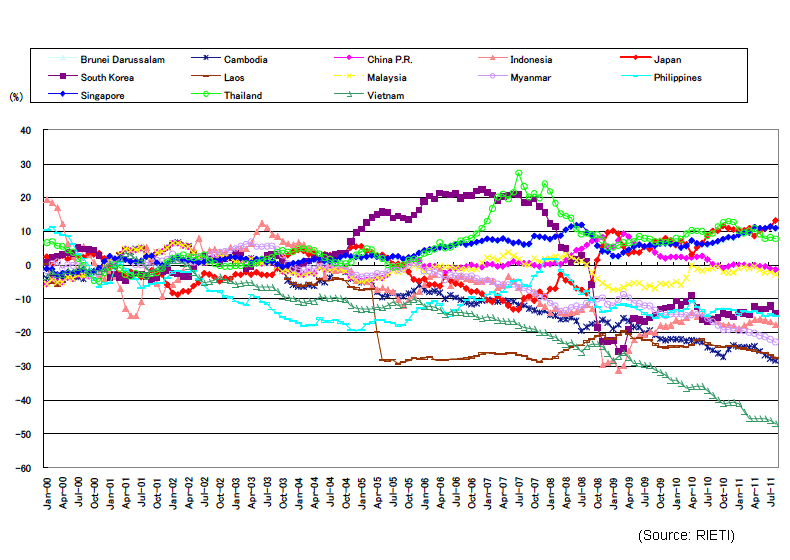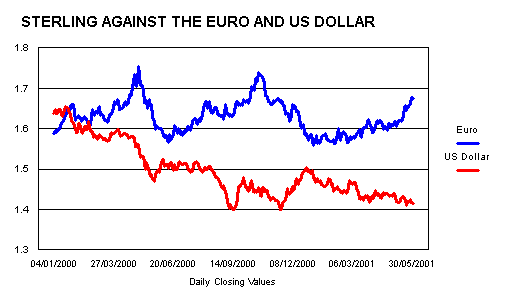Real effective exchange rate
Post on: 12 Октябрь, 2015 No Comment

The real effective exchange rate measures the value of a currency against a basket of other currencies; it takes into account changes in relative prices and shows what can actually be bought.
Nominal exchange rate
The nominal exchange rate measures the current value of a currency against another. For example, in Sept 2014
£1 $1.61 or $1 = £0.62
Effective exchange rate
The effective exchange rate measures a currency against a basked of other currencies. This is usually trade-weighted. When looking at the effective Sterling exchange rate we will compare the value of Sterling against our main trading partners The Euro, the Dollar, the Yen e.t.c and give a weighting depending on how much we trade with that country, e.g. Eurozone 60%. A weighting will be given to different trading countries depending on how significant they are.
The effective exchange rate is good for looking at the overall performance of a currency. For example, the Pound may appreciate against the Dollar but this may be due to just temporary weakness in the Dollar. However, if the overall effective exchange rate increases, it suggests the Pound is becoming stronger.
Real exchange rate
The real exchange rate measures the value of currencies, taking into account changes in the price level. The real exchange rate shows what you can actually buy. It is the value consumers will actually pay for a good.
RER = E.R *(price level in country A/Price level in country B)
Increase in real exchange rate
- If a countries real exchange rate is rising it means its goods are becoming more expensive relative to its competitors.
- An increase in the real exchange rate means people in a country can get more foreign goods for an equivalent amount of domestic goods.
- Therefore an increase in the real exchange rate will tend to increase net imports. Foreigners will buy our less expensive exports. It now becomes more attractive to buy imports. This can cause a widening of the current account deficit and lower domestic AD. It will also help reduce inflation.
- Similarly a fall in the real exchange rate should increase net exports as domestic goods are more competitive.

(Readers Question: Does an increase in Real Effective Exchange Rate increase or decreases international competitiveness for the country? An increase in the real effective exchange rate will decrease international competitiveness. It means the country has relatively more expensive exports, leading to a fall in net Ex)
Inflation and the exchange rate
If the UK experienced inflation of 10% and US had inflation of 0%. We would expect the nominal value of the Pound to fall 10%. In this case, the real exchange rate would stay the same. The Pound has fallen 10%, but British goods are 10% cheaper. The amount of goods you can buy stays the same.
Example of Real exchange rate
- Suppose there is just one good that is traded. If the good costs £100 in UK and $100 in the US. The real exchange rate is 1:1
- If the nominal exchange rate was £1 = $1. Then the real exchange rate is the same as the nominal exchange rate. There is perfect purchasing power parity (PPP). It makes no difference whether you buy the good in the US or UK.
- Now suppose that the cost of British goods increases. That good now costs £120 in the UK, and $100 in the US. This means that the good in terms of Pound is 1.2 more expensive than the Dollar. The real exchange rate is £1.2 = $1
- If the nominal exchange rate is still £1 = $1, what will consumers do? They could buy the good for $100 in the US and sell in the UK for £120. They will make a profit because selling for £120, they can convert into $120.
- Therefore, we would expect the nominal exchange rate to adjust to reflect the real changes. If goods in the UK are more expensive, we would expect the Pound Sterling to fall in relation to the dollar.
- In theory, the nominal exchange rate should reflect the real exchange rate. If the nominal exchange rate rises to £1.2 = $1 then there is no profit to be made from buying goods in the US and selling in the UK.
- In the real world, there are numerous goods, so that we used average price indexes to indicate relative movement in the price of goods.
Changes in real exchange rate
If a country experiences rapid productivity growth, then it can enable lower costs and lower price level, this will help to reduce the real exchange rate.
Misaligned real exchange rates
Suppose that prices in country A increase, this decreases the real exchange rate. However, if the nominal exchange rate is kept constant, then we can see a misalignment between the exchange rate and its real value
A good example is the Pound Sterling in the ERM crisis. In 1990, the UK entered the ERM a semi-fixed exchange rate mechanism. This tried to keep the value of the Pound at a fixed rate against the German D-Mark. However, in the late 1980s, the UK experience high inflation and then a recession. The market value of the Pound started to fall, to reflect the real changes in the exchange rate.
However, the government (rather artificially) were trying to keep the value of the Pound high and constant in the ERM. Therefore, they intervened on the foreign exchange markets buying Pounds and increasing interest rates to keep the value of the Pound high. Therefore, the nominal exchange rate became overvalued against the real exchange rate. But, eventually, the attempt to keep the nominal value of the Pound high failed. Markets correctly predicted that the Pound was overvalued. Intense selling of the Pound eventually forced the UK government to leave the ERM and allow the Pound to devalue coming closer to its real exchange rate.
This was an example of the nominal exchange rate being overvalued compared to its real value.














